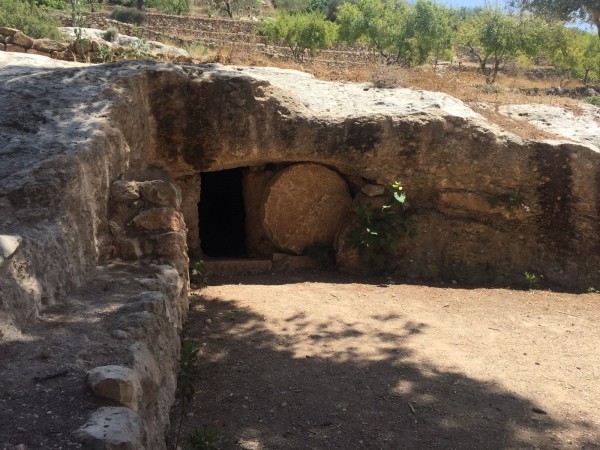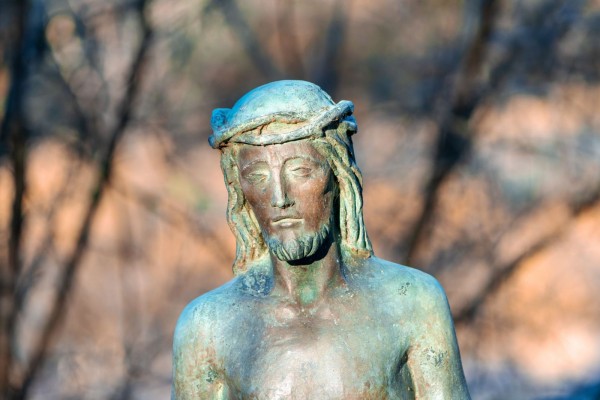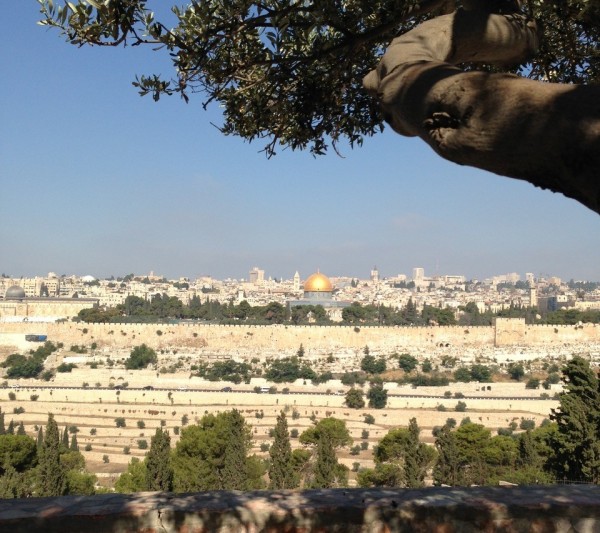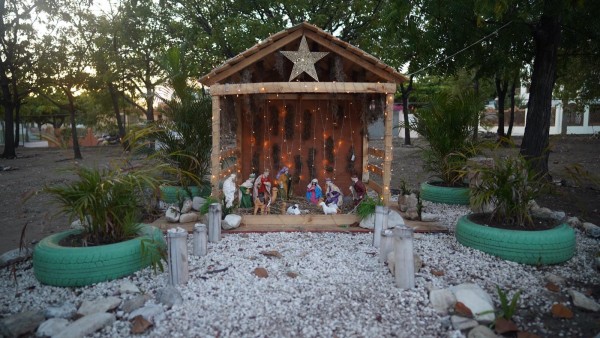
When we read the passion in all four gospels, we can see that there are slight variations about the people present at the crucifixion and burial of Jesus. Interestingly, from all the followers of Jesus that are mentioned in the gospels, there are two people who are always present in all four accounts: Mary Magdalene and Joseph of Arimathea (maybe three with Mary the mother of James and Joseph, See Matt 27:55-28:1; Mark 15:40-16:8; Luke 23:49-24:12; John19:25-20:1). This year on Palm Sunday and Good Friday we read according to Matthew and John that Joseph of Arimathea went to Pilate and asked for the body of Jesus, of whom Joseph was a disciple. He then buried Jesus in a tomb cut on the rock (Matt 27:57-61; John 19:38-42). By ensuring that the body of Jesus was properly buried after the crucifixion, Joseph of Arimathea becomes a key character in the passion narrative. Mark and Luke add more information about Joseph, noting that he was a member of the Sanhedrin (Mark 15:42-47), that he was a righteous man and that Joseph himself took Jesus down from the cross (Luke 23:50-56).
Joseph’s direct request to Pilate to bury a crucified man and Pilate’s approval are, if not problematic, surprising elements from both a narrative and historical point of view. Regarding historicity, it has been noted that the shame of the Roman crucifixion included the denial of a dignified burial. Romans preferred that corpses would decompose on the crosses (this information can be found in any modern commentary on the Gospels, my favorite being that written by Craig S. Keener on the Gospel of John in 2003). From a Jewish point of view, the request to bury Jesus is reasonable, given the command from Deuteronomy 21:22-23 that no corpse shall remain overnight unburied because of the risk of defiling the land.
Additionally, the sudden intervention of Joseph of Arimathea and his disappearance from the narrative afterwards, makes this character notable. A man who has not been mentioned before at all, takes the central place on burying Jesus and ensuring that the prophecy of the resurrection might take place. It is not Peter, nor John, nor any other disciple who takes on this essential part of the passion of Jesus. All four gospels mention Joseph and in all four he appears unexpectedly to fulfill this important duty. And after the burial, Joseph of Arimathea is never mentioned again.
Joseph of Arimathea’s role makes me think of another Joseph that after playing an important part in the life of Jesus disappears and is never mentioned in the gospels: Joseph of Nazareth. Just like the man from Arimathea, Joseph of Nazareth is there to help fulfill the prophecies that Jesus shall be called Son of David (Luke 1:32), that the Messiah was to be born in Bethlehem (Luke 2:4-5; Matt 2:5-6), and that out of Egypt he was called (Matt 2:14-15). Joseph of Nazareth married a woman that was expecting not his child and thus defied a law that requires to denounce Mary publicly (See Lev 20:10; Deut 24:1). Yet, after playing a fundamental role in the life of Jesus, we do not read more about him in the gospels.
Both Joseph of Nazareth and the man from Arimathea come and go in crucial moment of Jesus’ life; just when Jesus needed them the most. There was a Joseph to place Jesus in the manger and a Joseph to place him in the tomb. Both Josephs, the carpenter and the member of the Sanhedrin, act against all odds to ensure critical episodes in the life of Jesus. This idea becomes even more attractive highlighting the etymology and Hebrew root of the name Joseph: May God add, or may God give/increase. I cannot but see Joseph’s name operating in relation to what both men from Nazareth and Arimathea did for Jesus. At the moments when Jesus was most vulnerable, his birth and death, God added, provided, with these two men to be support and to provide for Jesus. These details crate a “Joseph motif” in the canonical gospel’s where both Josephs are called righteous, and they perform indeed virtuous acts for the most vulnerable at that time.
The questions to reflect is how can we be like these Josephs for other people? Are we willing to be there at for the most vulnerable to help them, nurture them, and provide for them? Are we willing to be Josephs that do not need to be all the time at the center of people’s stories, but rather quietly help them?

This past Tuesday I led a reflection about the role of Judas, Mary Magdalene, and Peter in the passion narrative for the Catholic Community in Central Racine. We discussed the meaning of the washing of feet that we have ritualized for Holy Thursday liturgy. Using Lectio Divina and with the help of some biblical anthological insights we reflected on Judas’ person first. I started the discussion asking people, have you ever thought about Jesus washing the feet of Judas? Every Holy Thursday we read the account of the washing of feet from the gospel of John 13:1-15. At the beginning of the narrative, we read that Judas is present there, decided to hand Jesus over to the religious authorities. It is after the washing of the feet and after receiving bread from Jesus that Judas leaves the room (John 13:30). This means that Jesus washed Judas’ feet and shared bread with him. According to the gospel of John, Jesus knew that Judas would betray him. This makes the image of Jesus washing Judas’ feet even more striking.
For many of us, Judas is only the betrayer. If we are left only with the story of the passion, especially from the gospel of John, Judas is a thief (John 12:6) and someone induced by the devil and even possesed by Satan (John 13:2; 13:27). Equally infamous are the kiss of Judas found in all three synoptic gospels (Mark 14:45; Matthew 26:49; Luke 22:47), and the thirty coins of silver that accepted to betrayed Jesus (Matthew 26:15). Matthew and Luke differ on how he died, but Matthew’s version (27:5) of Judas taking his own life is the most popular one. I would suggest you also read Luke’s version (Acts 1:18).
We can only but imagine how Jesus felt washing the feet of someone who will betray him. But Judas was certainly more than that. His feet were not only the feet of a betrayer but the feet of one who brought good news. Judas was commissioned with the other disciples by Jesus to proclaim the gospel (Mark 6:7-11; Cf Matthew 10:1; Luke 9:1-5). Judas even received power to cure illnesses and he with the other disciples reported how successful they were! (Mark 6:12-13, 30-31). For some people he was not the betrayer, but Judas the Healer, or Judas the Apostle, Judas the instrument of God’s grace and love. His feet not only walked the way of betrayal but the way of successful mission of caring for the poor and the sick. Judas’ feet brought good news and healing into the life of others, and I think that is something Jesus did not forgot as he washed them. I am aware this is the area of speculation but the image of Jesus washing his disciple’s feet is one worth praying and thinking about.
Bruce Malina in his Social-Science Commentary on the Gospel of John (1998, 223) says that traditional Mediterranean anthropology understand the human experience within three zones of interaction: eyes-heart, mouth-ears, hands-feet. The last pair represents our actions, performance, doing or making. Malina then suggests that when Jesus washes the disciples’ feet he is washing away, that is forgiving, their wrongdoings even the future ones. This idea makes sense since the beginning of the washing of the feet scene in John begins stating that Jesus loved his own to the end (John 13:1). I like to think that Judas’ feet remind Jesus of how they carried good news and walked dusty roads to bring hope into the lives of others. I would like to finish with a quote from the book of Isaiah as we think of Judas’ feet: “how beautiful upon the mountains are the feet of the messenger who announces peace, who brings good news, who announces salvation” (Isaiah 52:7).

Epiphany! A word that does not appear in the bible but has been used to describe the manifestation of Jesus as Messiah and God to the nations. There is no secret meaning or complicated message in the Gospel for this solemnity. The Magi, people who were non-Jews came from a foreign country to do homage to Jesus, a newborn King. For the Magi, Jesus is a King, a Messiah, a Savior, and a God. It really didn’t matter that they were not Jews.
Don’t you think it is interesting that Herod and all of Jerusalem, who were so close to Bethlehem, were unable to see the star? And even more interesting is to think that even after being told by the Magi, Herod and the people were unable to see the star? “Go and search for the baby, and then tell me,” Herod tells them. In this story only the magi can see the star.
To understand this, we need to know that Jerusalem in the Gospel of Matthew is not only a geographical place. It is also a state of mind, an attitude. To be in Jerusalem is to belong to a closed, exclusive, rigid, nationalistic mentality. In the Gospel of Matthew, it is the center of national Judaism. Those who believed that Yahweh was their God and salvation was only theirs. These people were unable to accept that the light of God can shine far beyond their city and their own people. They aimed to monopolize God’s grace. But as we see in the Gospel, the star shone for gentiles, and the first worshipers of Jesus were what rigid Jews will call unclean, pagans, or just foreigners.
This writing from Matthew could have created a little bit of discomfort for some people. But Matthew had a mixed church, his Gospel was written for a mixed community of Jews and gentiles. Hence the value of this story for him. Whenever we try to be exclusive and treat the Church as a club were only chosen people can enter and receive God’s grace, we blind ourselves to the wonders and to the light that God shares upon others who may never be part of the Church. To be true to its founder (as many say Jesus is), the Catholic Church must always be inclusive. We who now share in the body of Christ have the responsibility to extend that grace and love to all, no matter who that person is.
Today we celebrate the revelation of our God as a God that is for all, as a God that loves all, as a God that welcomes all. The story of the Magi teaches us that God’s signs become invisible for those who are not inclusive and try to monopolize his grace.

This weekend we celebrate Christ the King and with this solemnity we come to end of our liturgical year. I have always pondered about the meaning of this celebration in light of a passage in John 6:15: “When Jesus realized that they were about to come and take him by force to make him king, he withdrew again to the mountain by himself.” In this passage, after feeding five thousand people (read John 6:1-14), Jesus is reluctant to be seen as a king. Why? Maybe was not the right time to do that? Or could it be because the motivation behind the crowd to make him a king? I believe it is because of the motivation of the crowd. Who does not what a king that can multiply bread?! Jesus of course is willing to feed the hungry, but if the miracle is always done by Jesus, we might forget that through generosity, giving up our own interests, we can also feed the hungry. It is easier to have a king that solves our problems. It is harder to work on those problems ourselves, especially when we must give up from our own goods and efforts.
I also believe Jesus was reluctant to be seen as king because of the political and elitist connotations that come with it. A king is sociologically a superior member of society. This idea contrast sharply with a God who became one of us and adopted our humble human nature.
Indeed, the Hebrew bible is concerned with any elitist attitude on behalf of the king. The book of Deuteronomy not only contains the only law impose on kings in those times but also states that any king in Israel should not “exalt himself above other members of the community” (Deut 17:20). Also, the idea of Jesus being a king, separated from us is less challenging than seeing him as equal to us, someone to follow and imitate. I do not doubt the title of king is indeed appropriate for Jesus as he is indeed our God, the only one to be praised. I just hope the idea of his kingship do not take away the responsibility we have to imitate him in his humanity and do not make us passive spectators that only ask for favors. His kingship is proper for the praise due to him, not to consider him an unreachable monarch whose only job is to grant favors to his people.
One of the greatest modern myths we have in our society is that of the self-made man. From the day we are born we are told that we can do anything and become anyone we want to by our own efforts. If you go to a bookstore (or online) there is a whole section of books dedicated to self-improvement. Titles as Seven Habits of Successful People or Master Your Mind are everywhere nowadays. But while perhaps good intentioned, such concepts are misleading, for no one can grow by himself or herself. Maturity and personal development are achieved by our interaction with others, even if only in a passive way. The influence of other people in our lives is always a factor in who we are now and who we will be in the future. This does not undermine the power of one´s determination and the autonomy we can have in making our own decisions, but it is arrogant to think that we “made” ourselves only by our own choices and that the input and interaction with others does not have an affect on our person.
This made me think of Peter and Paul whom we celebrate today. If you have ever been in Rome at Saint Peter’s Basilica or if you have seen a picture of the facade, you will see the statutes of Peter and Paul right at the entrance. These are very majestic images that isolate these characters from a rich history of conversion that involved other people. As much as Peter and Paul are the pillars of our Church, they too underwent a process of change in which other people directly influenced their vocation. Two clear examples are Cornelius and Ananias. Their influence on Peter and Paul reminds us that even for those who become the foundation of the Church, help from others was needed.
Both stories regarding the conversion of Peter and Paul are in chapters nine and ten in Acts, and they are remarkably parallel to one another. In chapter nine we find the story of Paul’s conversion, with which most of us are familiar. Paul, still called Saul, is on his way to Damascus when he has his encounter with Jesus. After this, he loses his sight and for three days waits in Damascus in the house of a man named Judas. Meanwhile, Ananias, who is called a disciple, has a vision in which the Lord asks him to go and find Saul. Ananias is reluctant since he knew who Saul was. But the Lord insists saying that Saul has been destined to become an instrument to bring the name of Jesus to the Gentiles (Acts 9:10-16). Ananias goes and lays his hands on Saul, and he recovers his sight. After this, Paul will then preach that Jesus is the son of God.
At the end of chapter nine, which is mostly dedicated to Paul's conversion, there is then an introduction to Peter, that places him in Joppa in the house of a man named Simon who is a tanner. (Acts 9:43). This is a curious place for Peter to stay, since a tanner should had been seen as an unclean person with respect to Jewish purity laws. A tanner was constantly handling carcasses and skins of dead animals. But Luke, the author of Acts, want us to prepare for what is coming, putting Peter in relationship with someone who shares his Jewish name but who is seen as unclean. The following chapter ten introduces Cornelius as a devout Roman centurion who feared God with all his household and who lived in Caesarea. A God fearer was non-Jew who accepted the Jewish faith and followed part of the Law but without being circumcised. One day at three o'clock Cornelius has a vision in which the Lord reaffirms Cornelius’ devotion and asks him to look for Simon Peter who is staying at the house of Simon. At this point, this sounds very similar to what happened to Ananias in chapter nine.
Next, Peter has a vision on the roof of the house where he is staying. In the vision, Peter sees the heavens opened and a large sheet coming down, lowered to the ground by its four corners (Acts 10:11). The sheet had in it all kinds of four-footed creatures and reptiles and birds. Three times Peter sees the sheet coming down and a voice telling him: “get up Peter, kill and eat.” But three times Peter denies the offer since he should not eat anything unclean; but the voice also answers three times: "what God has made clean, you must not call profane." One must wonder if this also applies to the tanner. Peter did not know what to do with his vision until the next day when he arrives in Cornelius' house and realizes that although it was unlawful for Jews and Gentiles to associate, he should not call anyone profane or unclean. After this Peter preaches in Cornelius' house that God shows no partiality. While he does this, the Holy Spirit falls upon everyone there in what it looks like a second Pentecost, since the Gentiles also start to speak in tongues just as the disciples did at the beginning of the book of Acts (compare Acts 2:1-4 and 10:44-46a).
We can see similar, striking elements in these stories. Both Peter and Paul have visions and are staying as a guest in some individual's home whose name/profession is significant to their experience of conversion. Also, for both men the mission to the Gentiles is linked to their conversion experience. But the most interesting parallel is the intervention of Cornelius and Ananias. When Cornelius and Ananias are called by God, they are called by name, and they have a specific instruction. Both are crucial in helping Peter and Paul understand that God shows no partiality. We may regard Peter and Paul as the disciples who stand at the foundation of our Church but we have to recognize that they did not reach to that point by themselves. Cornelius and Ananias, through the intervention of God, were instrumental for them to “see the big picture.”
The experience of conversion is not a mere personal matter; we all need people like Cornelius and Ananias to help us to see and grow. These two men are sent by God to help others fulfill the mission that from the beginning was given to the apostles of proclaiming the Gospel to everyone. Even Peter and Paul, the two pillars of the Church that we celebrate today, required the help of others to become better disciples.
A reflection on Good Friday

Every Good Friday we have the narrative of Jesus’ passion from the gospel according to John. In the account, when Jesus is going to be sentenced to death, Pilate asks the crowd “Shall I crucify your king?” Surprisingly, the answer does not come from the crowd. Rather, we read that the chief priests reply, “we have no king but Caesar” (John 19:15). This sentence is, what I believe, one of the greatest ironies that the gospel according to John offers. The reason behind lies in Israel’s notion of kingship, especially during the time of Jesus.
Although we are used to hearing the terms messiah and Son of David being connected to Jesus in a positive way, the earthly institution of the monarchy was not always perceived positively in Judaism and the Hebrew Scriptures. Israel was, in fact, a nation destined to not have a king. Even more, God warns against the idea of a human monarch through the prophet Samuel (1 Samuel 8:10-22). But the people of Israel wanted to be “like the other nations” and they insisted they needed a king. God grants their petition, and a catena of unsuccessful kings starts with Saul. There were even great problems with David and his son Solomon, who according to the books of Kings violated the only law that kings had to obey (Deuteronomy 17:14-20; 1 Kings 10-11). The monarchical institution was so unsuccessful that Israel ended up divided, destroyed, and exiled.
After the Babylonian exile, when the people of Israel are able to return (through God’s intervention), the monarchy is seen in a different light. Only God is the true king of Israel. They should have not put their trust in princes nor mortal man, only in God (Psalm 146:3). This reflection is seen clearly in the composition of the Book of Psalms. If we read carefully in the way the psalms are organized, we will see that the first three books of the Psalms (Psalms 1-89) contain the history of the Davidic monarchy, including his sins, and which ends with God’s rejection of David (Psalm 89:39-46). In the rest of the collection, especially in Psalms 90-96 we find the confession that God is King, leaving behind any desire for a human monarch. This idea became stronger after their reflection of a failed monarchy. Of course, the desire to reestablish the Davidic monarchy was kept alive in small circles; we see this reflected in the gospels. Jesus is given the title of Son of David by individuals and crowds in the gospels, but even he sees the dangers of thinking about him as another “earthly king” (John 6:15).
Let us now return to the dialogue between Pilate and the crowd. What an irony is that the chief priests, who most probably prayed day and night with the psalms, proclaim Caesar as their only king. But why? They are willing to betray their own core belief that only God is king of Israel in order to get him rid of Jesus. “We have no king but Caesar” is the culmination of a plot to get Jesus killed by the Romans. They clearly chose to go against a core belief and even side with their oppressor in order to sentence Jesus, who threatened their social position and religious authority (John 11:48). These religious leaders were so afraid about the idea of Rome taking away their temple that they betrayed their own religion in order to maintain the status quo. This irony is not new in Scriptures. It is also prefigured in the Exodus story when the people of Israel after being freed from Egyptian oppression, longed for the false security they had in Egypt. They preferred the comfort of food while being enslaved in Egypt instead of the freedom and hard life in the wilderness (Exodus 16:3).
This Good Friday is a time we can reflect on how our fears may be leading us away from God and how we may be holding onto some false “kings” in order to feel safe and protected. For the religious leaders of the passion narrative in John, Caesar became a false protection. They rejected the unconventional message of freedom given by God in Jesus and they held onto what they knew was safe even in the midst of Roman oppression. For the people of Israel in the wilderness, Egypt became a false security longing for it and protesting against Moses who led them to freedom. We may feel secure with a political party or an economical system but the fear of losing such security may be holding us back from the mission of the Gospel, and at the end we may be proclaiming a candidate or a political party our “king.” May fear never hold us back to be generous or to betray the gospel of Jesus. The cross we celebrate today is the opposite of a life filled with fears.

The title of this article is a question that not only Mary Magdalene who came to anoint Jesus’ body on Sunday morning asked herself (John 20:1-9), but it is also a question that is in our minds right now. When public masses where suspended in many dioceses around the globe, many people ask themselves what are we going to do if we cannot receive communion? And after celebrating the mass with an empty church some of my friend priests were explaining how it was indeed a staggering experience. The actual situation of the Church in times of the COVID-19 is affecting everyone in our parishes. With no public masses, both priests and laity are struggling to find ways to continue feeding their faith. No doubt the measures taken have seriously affected the spiritual needs of numerous people. But if during the pandemic you only worry about how to deal with the quarantine without the Eucharist and with empty churches, consider yourself lucky. The quarantine is making numerous people ask themselves not only how to satisfy their sacramental needs, but also what they are going to do without the bread and with empty stomachs. Entire families that depended on their daily work to survive are now in dire need because they cannot go out to work. My intention is not to create a dichotomy between the sacramental and the physical needs. Both are essential for people of faith. But the present situation and the readings for Easter Sunday have made me reflect how the absence of the body described in the resurrection narrative can take a special meaning, especially for those who are now suffering hunger because of the pandemic.
When all this started, I saw many creative ways in which pastors and parish staffs reached out to parishioners. Social media and streaming services became useful to ensure that parishioners felt connected to the celebrations and that their spiritual life was being taken care. I have also seen many efforts by religious and non-religious groups to ensure that people do not go hungry during the pandemic. Parishioners and priests who I personally know have organized themselves to deliver bags of food for those whose daily income has been affected by the pandemic. But even after COVID-19 there will be people who ask this question every day: what am I going to do without bread and with an empty stomach? I believe this current situation has shown we can be ready to act and help to provide. The Church has shown that during the pandemic, it can provide for both the spiritual and the physical needs of those in need.
After the crucifixion, when she saw that there was no body but an empty tomb, Mary Magdalene run to Peter and the other disciple thinking the worst: the body is gone forever, and they will never find it. A reasonable deduction when all hope is gone. We are invited during this time to continue hoping and believing, that after the pandemic, we will continue to receive the Body of Christ. The reaction of Mary Magdalene is the reaction of someone who longs to see Jesus again; a reaction many of us may also have now in a moment of spiritual hunger. As some of us share with her our hunger for the Lord, let us not forget, while we wait for him with hope, to satisfy the hunger of those who lack bread now because of COVID-19. Let us not forget that “the joys and the hopes, the griefs and the anxieties of the people of this age, especially those who are poor or in any way afflicted, these are the joys and hopes, the griefs and anxieties of the followers of Christ” (GS1).

It is Christmas, and I have the privilege of spending this cheerful time in La Sagrada Familia Parish in Sabana Yegua , Dominican Republic, with my Community of Saint Paul family that lives and works here. I came just at the beginning of the Advent Season, during which we are called prepare ourselves to celebrate the birth of Jesus. And as part of this preparation, the church here is cleaned and decorated to evoke the anticipatory nature of the time before Christmas. As one would expect, part of the decoration is the Nativity set, for which a wooden house has been built. Inside there are the usual suspects: Joseph, Mary, the donkey, the ox, the shepherds, the Magi, the star and the angel; baby Jesus is, of course, “hidden” until midnight on Christmas Eve.
The imagery of the Nativity, or Creche, captures the two Christmas stories we have in the Gospels of Luke and Matthew. That is right, we have two Christmas stories, and we use them as if they were one. The shepherds are only in Luke’s account, while the Magi are in Matthew’s story. The star is only in Matthew, while the angels are part of Luke’s narrative. But when we built our Nativity set, we blend all the elements to reconstruct the familiar image we have known since we were children, including that one sheep that is missing a leg and we spend the whole season trying to make it stand. After some time contemplating our Nativity set here in Sabana Yegua, I asked myself, why do we need two Christmas stories?
Matthew and Luke are the only two gospels that tell us about the birth of Jesus. Matthew 1:18-2:23 tells us the story from Jesus’s birth in Bethlehem to the flight to Egypt and his come back to Nazareth where he grew up. In these few verses, we are told how the Holy Family starts with the shameful situation of Mary being pregnant, but not from her future husband. This is certainly a problem in a small town, and most probably a penalty paid with death. Nevertheless, Joseph is advised to proceed with the wedding and take Mary to his home. When Jesus is born, he is manifested to foreigners, that is the Magi, not to his own people, and even less to the religious leaders of that time. After this, they face persecution and emigrate to Egypt where Jesus escapes death.
Alternatively, Luke does not tell us about Jesus birth but until the second chapter, and in 40 verses he describes the birth, manifestation to the shepherds and also to two elderly people in the Temple. Luke is the one telling us of the struggles of the Holy Family to find shelter and a place to stay in Bethlehem. The image of the manger is found in Luke’s narrative and the revelation of Jesus to the shepherds is a the parallel to the Magi in Matthew. Again, in Luke, the son of God is not revealed to the religious leaders but to the humble shepherds.
The two different accounts are united in two fascinating insights: first, the Holy Family started with serious struggles; far from being a “perfect” family, they had a rough beginning. And second, the revelation of Jesus was first to people no one expected. Both Matthew and Luke agree in establishing Jesus’ origins as a critique to conventionalism. That is precisely what the Nativity set is; it is a symbol of what is unconventional. The poor, the stranger, the foster father, the manger… all of it speaks against the ideal situations we have created in society and in favor of realities and lives that many people strive to avoid. Nonetheless, this was the reality of Jesus’ birth. We have created molds and ideals that are almost impossible to attain, from a big house, the perfect family, to the ideal body, etc., believing that this is the only way that we can be fulfilled. We also have become a society that often rejects the immigrant and continues to forget about the poor. We live our lives chasing conventions which social media has promoted and falsely advertise as the “norm,” and when we do not attain them, we fall under the heavy weight of anxiety and failure.
That is why I believe we need both Christmas stories which are represented in the Nativity set. In a society of conventions and ideals, two stories that speak in different ways about the unconventional birth of Jesus offer us an unconventional reality. Hopefully, when we look at the Nativity set, we feel invited to free ourselves from any mold, expectation or idea of a “perfect” life we may have created as a yoke for ourselves.

The word for Lent in Spanish is Cuaresma, which comes from the Latin Quadragesima; that is, forty in ordinal numbers. That is because Lent (or Cuaresma) has as a direct root the forty days that Jesus spent in the desert fasting. The Church’s celebration of Lent is a tradition that goes back centuries. Nevertheless, with time and because of the idiosyncratic nature of the Church around the world, there is a biblical element that is an essential part of Lent that sometimes is left behind: Baptism. To see this clearly, we must go to the Gospel readings during this Lenten season.
There are several key Gospel readings for Lent, the first of which is the focus on Ash Wednesday. Every year, the reading is from Matthew, no matter the cycle. From there we have the three distinct practices of Lent: fasting, prayer, and alms-giving. And we are also reminded how we are to fast, pray and give alms. Jesus says: Take care not to perform any of these deeds that people may see them! (c.f. Matt. 6:1). The Gospel for the first Sunday of Lent does change according to the cycle, but they each focus on the same event in the life of Jesus: the temptations of Jesus during his forty days in the desert. Likewise, the reading for the Second Sunday also changes but focuses on the Transfiguration. With this common foundation, we then have different Gospel readings taken from John and Luke for the Third, Fourth, and Fifth Sundays.
Having the context of the readings, let us return to the First Sunday of Lent. Here, we will find ourselves with a very well-known passage in the Bible, that of the temptations of Jesus. In all of the Gospel traditions, we find that the reason why Jesus goes to the desert has to do with the Spirit. In Matthew, Jesus “was led up by the Spirit into the wilderness to be tempted by the devil.” (Matthew 4:1). Luke writes that “Jesus, full of the Holy Spirit, returned from the Jordan and was led by the Spirit in the wilderness, where for forty days he was tempted by the devil,” (Luke 4:1-2a). And finally, what we will hear this year in Mark: “And the Spirit immediately drove him out into the wilderness. He was in the wilderness forty days, tempted by Satan…” (Mark 1:12-13a). No matter the Gospel, the Spirit leads or drives Jesus out into the wilderness to be tempted.
Of course, this is not the first appearance of the Spirit; it has been introduced just before at the narrative of Jesus’ baptism. If we read Mark carefully, we find the adverb immediately, suggesting that the temptations are an urgent step for Jesus right after the baptism. In other words, the Spirit that Jesus received during his baptism, the one who came down as a dove, will produce this quick movement into the wilderness.
This shows a direct relationship to Baptism and facing temptation. At the baptism of Jesus, there is a voice from heaven that says Jesus is the beloved Son of God. And when we read the temptations, described in detail by Matthew and Luke, we realize that two of them start with the interrogative sentence “if you are the Son of God…” The voice of the tempter is in diametrical opposition to that of God. The temptations of Jesus in the desert, while provoking him to use his divine power to personal benefit and for the sake of display, are at their core the same temptation: to demonstrate that he is indeed the beloved Son of God. The tempter is putting the voice heard at Jesus’ baptism in doubt. The moment Jesus acts on the temptations, he already doubts the voice from heaven. It is then reasonable to believe that the Spirit that Jesus received at his baptism has driven Jesus into the desert to fasten his identity as the beloved Son of God; so that the love of the Father would never be put into doubt throughout his mission on the way to the cross.
I would suggest that the reaffirmation of our identity as beloved sons and daughters of God should be precisely one of the primary purposes of these forty days we call Lent. Our Baptismal Identity is crucial to understanding why Lent even exists. It is true that during Lent we practice penance as a way to be prepared for the Easter celebration. But while penance is necessary, it is not the first or only step in our Lenten preparation. Again, an essential part of Lent is to remind ourselves that we are beloved sons and daughters of God, and our acts of penance should direct us towards an experience of this.
As mentioned before, we will hear that voice again from Jesus' baptism during the Second Sunday of Lent. At the moment of the Transfiguration, a voice from heaven will remind the disciples: this is my beloved son. So, this Lent let us not forget our Baptismal identity. Before we rush to do penance, let us first evoke our identity as children loved by God. In doing so, our penance will be more profound, dynamic and fruitful.







